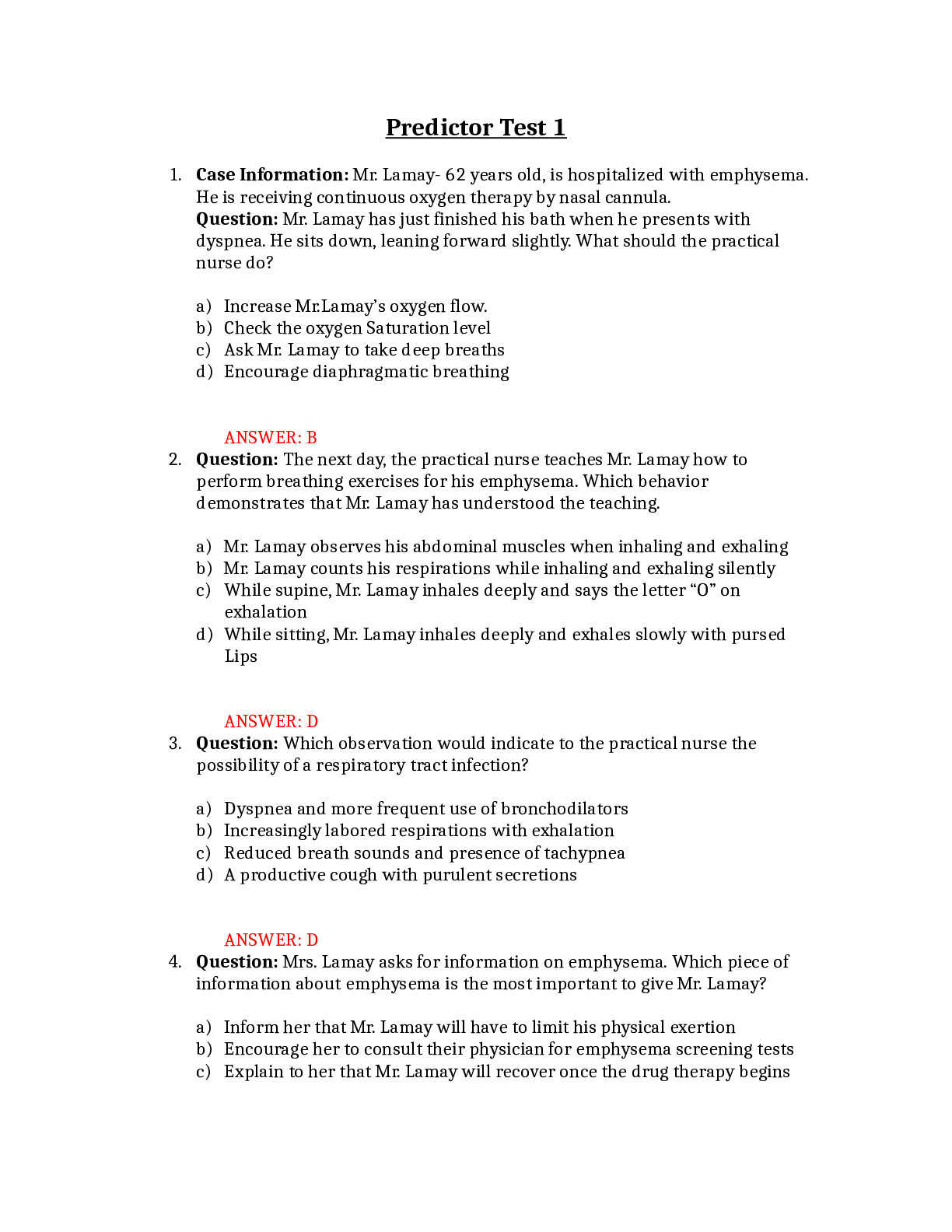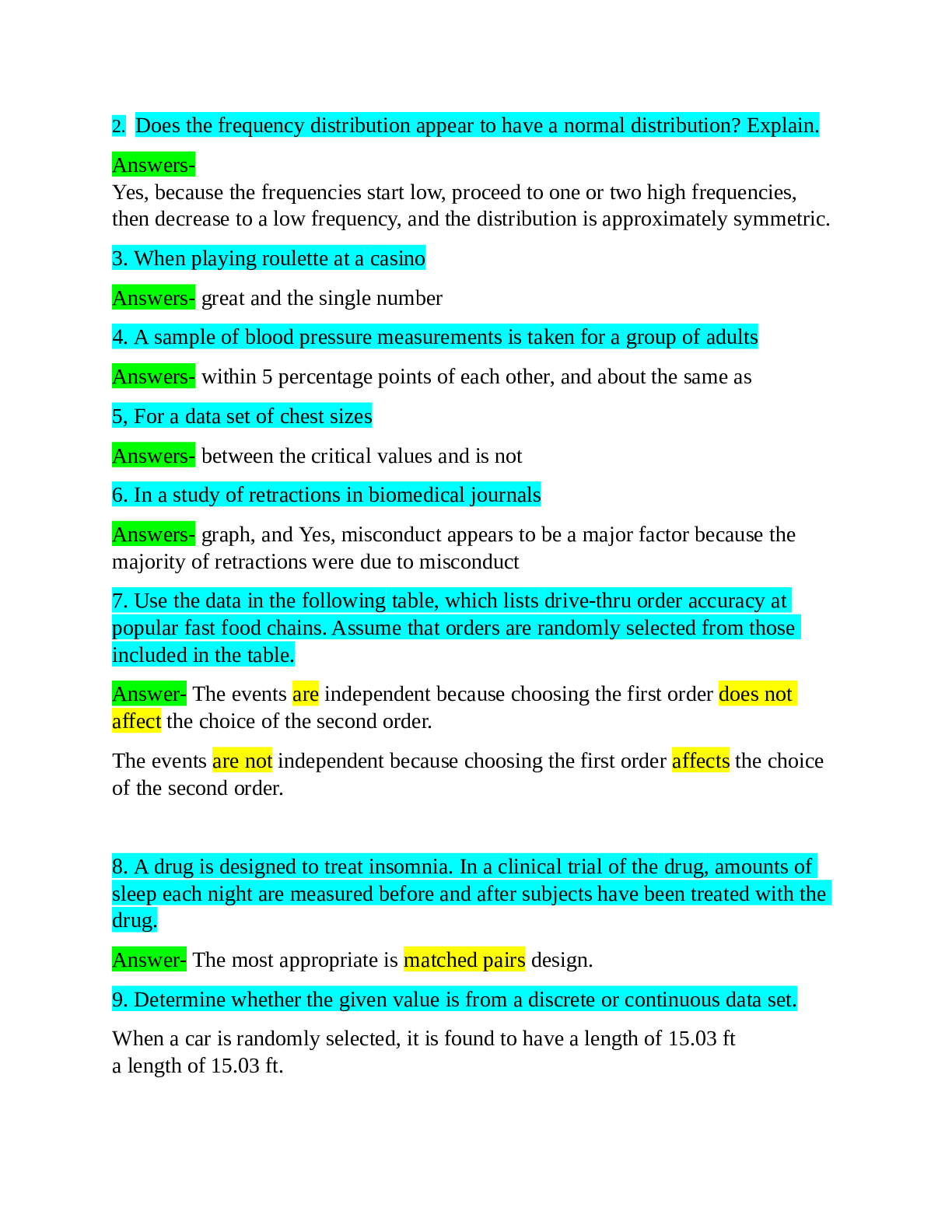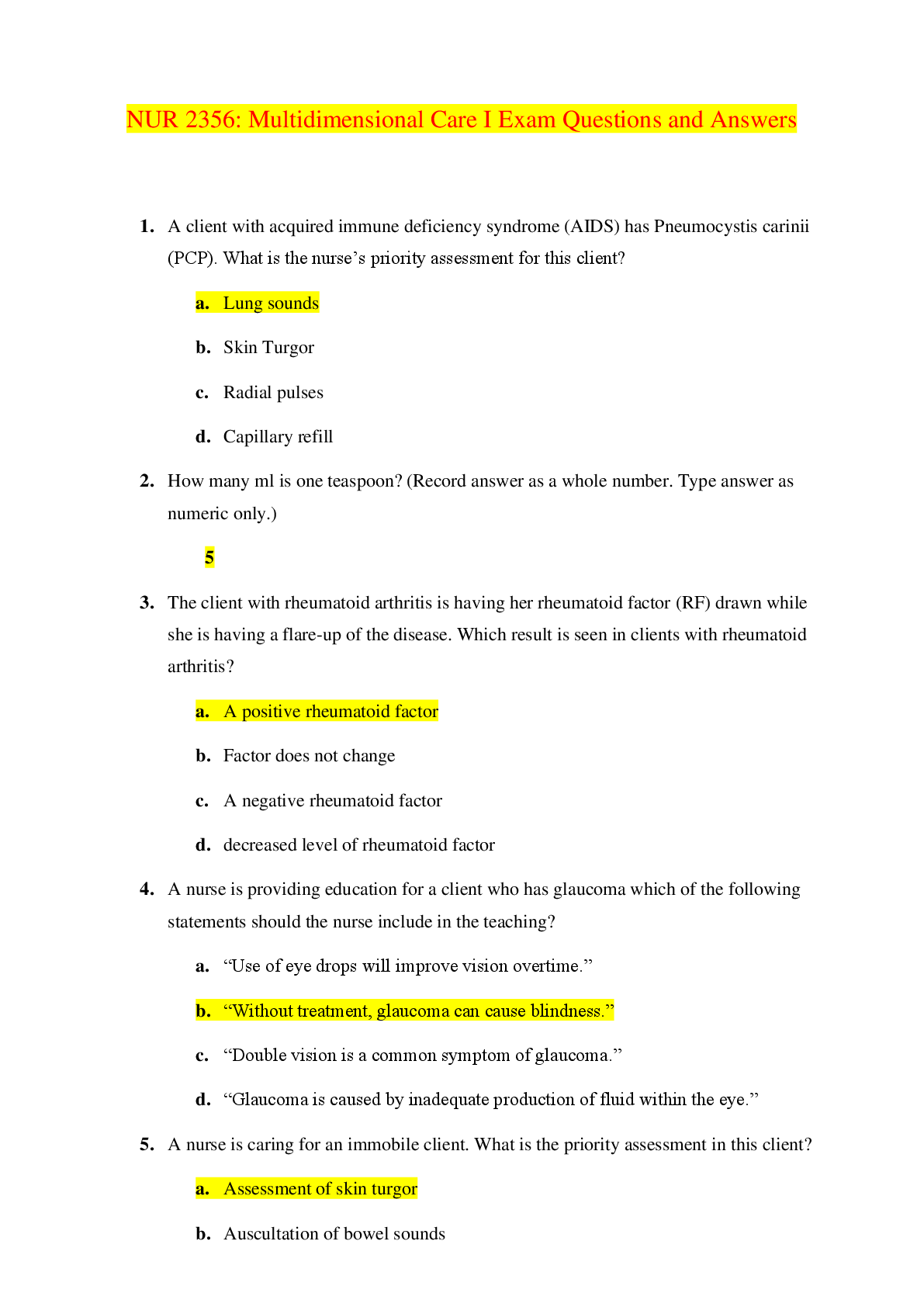Module 4- General Research Strategies and Designs_Study Guide for Final Exam
Document Content and Description Below
Module 4- General Research Strategies and Designs
1. Introduction
Design: a purpose or plan that is intended to build the scientific research presented
Selection of a strategy/design:
"The genera
...
l principle is that the research strategy/design must be appropriate for the research question you want to answer!"
(Robson, 2002)
Some (more practical) guidelines in order to choose the design of your research:
• The purpose of the research (describe, explain, explore)
• The framework of analysis (concepts, variables, indicators, theory)
• Research question (What data must you obtain?)
• Available resources (time, $, etc.)
• Epistemological perspective
2. A few definitions before you start
2.1 Types of design
Fixed vs Flexible
This is a way of categorizing research designs that is more representative of "real world research".
Fixed research strategy
The research problem is fixed at the beginning of the research process (before gathering data).
Flexible research strategy
The research problem is fixed a first time (before gathering data), however it can evolve with the context.
In a flexible design, the purpose of the research is also (usually) determined before gathering the data. However, the framework of analysis and even the research question MAY evolve according to the context.
This approach requires specific "aptitudes" on behalf of the researcher:
• Always have a holistic perspective of the research (purpose, previous knowledge, framework of analysis, research question, design, tools and techniques, etc.)
• Be on the lookout with the intention of adjusting the research problem, the general design and the methods
• Be able to adapt
• Grasp the issues of a situation
• Be objective all the time...
Deductive vs. Inductive
Deductive
Research is conducted in reference to a theory from which you test a hypothesis.
Inductive
Research is conducted in order to generate a theory.
Qualitative vs. Quantitative
This dichotomous way to divide types of design has the problem of not taking into account the fact that in general; the researchers are going to consider a mixed set of data. In a case study by semi-structured interview (qualitative data), a researcher who can have access to supplementary quantitative data is not going to ignore it because he has classified his research under the "qualitative" category.
Strategic Choice: An Overview (adapted from Bryman, 2006)
Strategy: some common perceptions
2.2 Sampling
Sampling
"Process by which a group of persons (the ‘sample') is chosen so as to represent a whole population." (Fortin, 2006).
The constitution of the sample can vary according to the purpose of the research and some other practical considerations.
Representativeness
• Essential quality of a sample.
• A sample is representative when it is a miniature replica of the population.
• To be representative, the sample must reflect the environment of the population and the characteristics of the individuals in the population.
• The population and the sample are eventually compared using statistics.
Sampling error
A sampling error is the difference between a parameter of the population and the sample.
Probabilistic sampling
• Method that consists of creating a sample by choosing individuals using a certain type of random assignment.
• EPSEM (Equal Probability of Selection): a design which allows every member of a population to have an equal chance to be included in the sample of the experience.
Examples of probabilistic sampling:
• simple random
• stratified sampling
• cluster sampling
• systematic sampling
Non-probabilistic sampling
Method that consists of constituting a sample by choosing individuals according to non-probabilistic criteria.
Examples of non-probabilistic sampling:
a. accidental
b. volunteers
c. systematic (without initial random selection)
d. typical
e. snowball
Examples of types of experiments with probabilistic sampling:
• pre-test / post-test / control group
• post-test only / no control group (TO AVOID)
• Factorial design
Quasi-experimental designs
Almost similar to an experimental design, but there is no random sampling and/or the comparison groups are not statistically similar and/or there is no direct manipulation.
In this type of design, there is sometimes no possibility of voluntarily introducing a change. The researcher must therefore compose with the "reality of the field"
Some reasons that lead to limiting the capacity to introduce a change:
• Impossible technically (e.g. characteristics of the individuals)
• Impossible ethically (e.g. consumption of drugs)
Sample and response rate
In addition to sampling techniques already discussed, it is important to comment on some widespread beliefs.
Sample size:
• Time & cost
• Anticipated response rate
• Heterogeneity of the population
• Type of measures
• Size of the population
Rule of thumb: the smaller the population, the bigger the sampling ratio:
• Small population (less than 1,000): about 30%
• Moderately large (10,000): about 10%
• Large (over 150,000): 1%
• The size of population ceases to be relevant once the sampling ratio is very small: @ 2500
Sample size (random) for different population with 99% confidence level
(Reproduction of a course of N. Petersen (DBA 6840); UQTR)
3. Research Designs
Research Design: Framework for the Collection and Analysis of Data.
We will study 6 types of designs (ref. Bryman table 2.1):
• Experimental (experiment, quasi-experiment & field experiment)
• Cross-sectional (survey)
• Longitudinal (cohort study; ethnography – over a long period of time)
• Case study (survey on a single case; grounded theory)
• Comparative (comparative survey; comparative case study)
• Mix-design
3.1 Experimental Design
Experimental Design
The researcher will actively and deliberately introduce a change in a situation, a circumstance or experience with the intention of producing a visible (measurable) effect.
• Selection of samples in a given population
• Allocation of samples to specific experimental conditions
• Introduction of planned change(s) on one or several variables
• Predetermined measurement on one or several variables
• One or more hypothesis in the research question (not always)
• Control over other variables
Objectives of Experimental Design
To assure the highest possible control in the research (eliminate alternative explanations, develop a logical explanation according to a statistical interpretation)
Experiment: 3 fundamental elements
• A manipulation (an intervention, a treatment, etc.)
• A control (a group of comparison)
• Random sampling
3.2 Cross-sectional Design
Cross-sectional Design
The collection of data on more than one case (usually quite a lot more than one) and at a single point in time, which are examined to detect patterns of association.
Often: Cross-sectional design = survey by questionnaire or by structured interviews NOT HERE!!!
Often this design is used within a FIXED strategy because you need to:
• Identify concepts & indicators at the beginning
• Compare the answers (so you cannot change the RQ)
10 items to consider when planning & writing about a cross sectional design
f. The sampling frame (list = Where?)
g. The dates where the survey will be conducted
h. Define adequately the population
i. The size of the sample
j. The sampling method
k. The measures
l. The tool (questionnaire; interview, etc.)
m. The stakeholders (Conflict of interest?)
n. The response rate
o. Incomplete rate
(Neuman, 2006)
3.3 Longitudinal Design
Longitudinal Design
A research in which data are collected on a sample on at least 2 occasions (BOF).
Design where time is a MAJOR issue in the RQ AND the validation process.
Three classic examples:
• Cohort study
• Ethnography
• Action Research
Ethnography
An ethnographic study gives a description (thick) and an interpretation of the culture and the social structure of a group.
Authors to know: W.F. Whyte; E. Goffman; H.S. Becker
• A central characteristic of the ethnographic design is the method used on the field. In general, an ethnographic studies is associated with the presence (interaction) of the researcher with subjects during a long period (on average 12-18 months)
• The common purpose of ethnographic studies consist in giving rich/thick descriptions and analysis
• Often, these studies are presented in a narrative form
• These studies will generally use participant-observation (tool). The role of the researcher will evolve between that of a neutral observer and that of a full participant.
• Ethnographic studies are based on a long tradition (e.g.: School of Chicago; Goffman, Whyte, Becker).
• These studies consider culture, behaviours, actions, routines and events shared by the studied group.
• To be able to give an ethnographic account, it is necessary to develop an "internalist perspective ".
It is therefore necessary to study groups in their natural environment.
• These studies consider qualitative and quantitative data
• It is possible to consider some specific concepts before getting out in the "field"
• Time in the field and "level of integration" are fundamental elements of the validity of the research
3.4 Case Study Design
Authors to know: Yin (1994)
Case Study Design
Exhaustive study centered on a single unit of analysis (individual, an event, an organization, etc.) Generally, a case study is done using a mix-strategy approach (qualitative and quantitative).
Case Study Design (According to Yin (1994))
An empirical study of a contemporary phenomenon in its real context by using numerous SOURCES of evidence.
A case study is...
• A design. It is not a method (in the sense of tools or techniques)
• A case study is empirical: it is based on the accumulation of data
• It is centered on a single unit of analysis
• Eventually generalization can be achieved by showing how the results can be transferred (not with a statistical logic)
• It takes into account the context
• It will use any type of data to achieve its goal
There are several types of case studies:
• Critical case study (validate/refute theory)
• Extreme case study (test the limits)
• Representative/Central
• Revelatory case study (explore or describe something new)
• Longitudinal case/Extended case study
Comparison: Case Study Design vs. Study by Sample (Adapted by Gauthier et. al., in 2006)
Classic Example: Grounded Theory (on a short period)
Authors to Know: Glasser and Strauss (1967)
Basic principle:
Design must allow the researcher to develop in situ the framework of analysis. In short, gathering the data, developing the framework of analysis and the research question is all done "in the field".
Some considerations on Grounded Theory (Strauss and Corbin, on 1998):
• The researcher must always compare (reduce biases)
• Get different perspectives (numerous methods)
• Periodically take breaks! (to develop an external perspective)
• Always be sceptical
• Master a large group of techniques (be wise!)
3.5 Comparative Design
Comparative Design
Studying 2 or more cases using more or less identical methods
Classic Example 1: Most similar design
Look for cases that are as similar as possible in all respects except the outcome of interest, where they are expected to vary (Gerring, 2001)
Classic Example 2: Most different design
Look for cases that are as different as possible in all respects except the outcome of interest where they are expected to be similar (Gerring, 2001)
3.6 Mixed Method Design
Mixed Method Design
Combining at least 2 designs in order to answer 1 RQ.
Classic Example 1: Convergent parallel design
[Show More]
Last updated: 3 years ago
Preview 1 out of 18 pages











.png)













.png)
.png)








 JN21.png)









